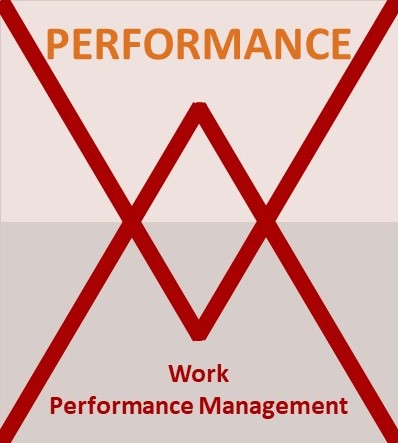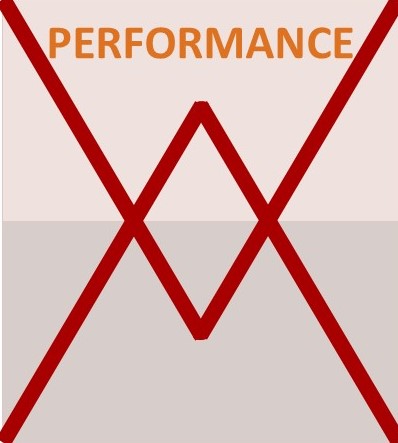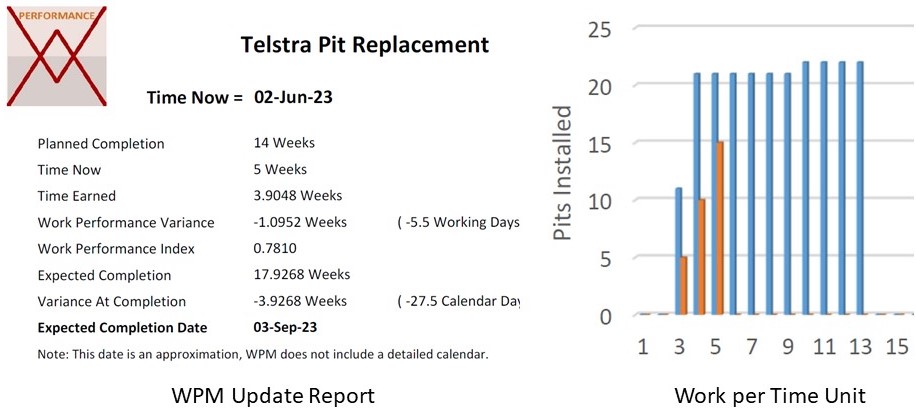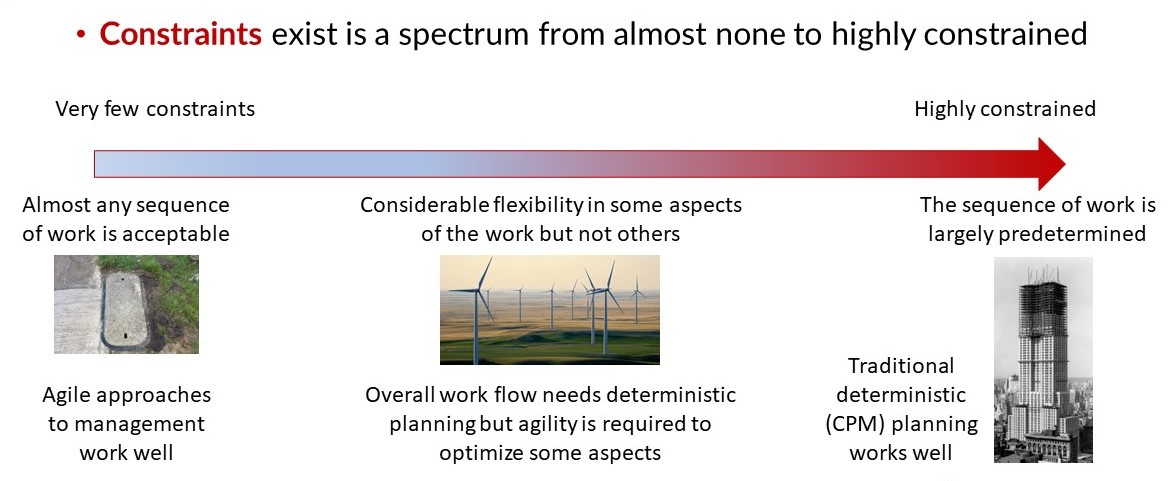Location:
PMKI > Project
Controls and Scheduling > Work
Performance Management.


- WPM Overview
- How WPM Works
- Using the Easy
WPM Workbook
- Applying WPM to
Agile Projects
- Applying WPM to
Distributed Projects
- Using WPM to
augment CPM predictions
Published Papers & Presentations
- Schedule Control in Agile and
Distributed Projects
- Work Performance Management - Predicting
Completion
- Assessing Delays in Agile and
Distributed Projects
- Useful External Web-links &
Resources.
Other related sections of the PMKI:
- Schedule
Challenges & Issues
- Schedule
control in Agile and Distributed projects
- Earned Value and Earned
Schedule
- Forensic analysis
- CPM Schedule Management
 WPM
is a methodology that has been developed by Mosaic Project
Services Pty Ltd to offer a simple, robust solution to the
challenges of providing rigorous project controls
information on projects that cannot (or are not) using the
more traditional controls paradigms of critical path
scheduling (CPM) and/or earned value management (EVM).
WPM
is a methodology that has been developed by Mosaic Project
Services Pty Ltd to offer a simple, robust solution to the
challenges of providing rigorous project controls
information on projects that cannot (or are not) using the
more traditional controls paradigms of critical path
scheduling (CPM) and/or earned value management (EVM).
WPM has two primary functions, calculating the schedule
variance at the update date, and predicting the likely
schedule completion date and variance at completion (VAC),
assuming the average production achieved to date continues
through to the end of the project. The basis of the
calculations are similar to Earned Schedule and Earned
Duration, but applied using a simple spreadsheet. The only
requirements needed to implement WPM are:
• A consistent metric to measure the work planned and
accomplished, and
• A simple but robust assessment of when the work was
planned to be done.
Art: Overview of WPM. Explains in more detail the theoretical basis of the Work Performance Management approach, and the simple framework needed to set up and use WPM on a project.
Because of its simple, robust, and defensible design, WPM
can be used on any type of project including:
- Any project using an Agile
or adaptive development methodology
- Traditional projects that are
not using, or are not suited to, CPM, and.
- To enhance the predictive
capabilities of project using a CPM schedule.
The development of WPM means there is no longer any excuse for a project team, senior management and/or the organization's governing body ‘not to know’ how the work of each project is progressing.
Note: WPM is not intended
as a replacement for either CPM or EVM on large, complex
projects.
- See more on Earned Value
and Earned Schedule
- See more on CPM Schedule
Management
 WPM
works by setting an expected rate of working using an
appropriate metric, then measuring the actual work
achieved to date. Based on this data, WPM can assess how
far ahead or behind plan the work currently is, and use
this information to calculate the likely project
completion date and VAC assuming work will continue at the
current rate.
WPM
works by setting an expected rate of working using an
appropriate metric, then measuring the actual work
achieved to date. Based on this data, WPM can assess how
far ahead or behind plan the work currently is, and use
this information to calculate the likely project
completion date and VAC assuming work will continue at the
current rate.
WPM works by comparing the amount of work achieved to
date with the amount that was planned to be achieved. The
basis of calculations used in WPM are the same as is used
in Earned Schedule (ES) , and therefore, a similar level
of usefulness and accuracy is expected from WPM. However,
compared to ES, WPM is much simpler to set up and use. The
only two requirements to implement WPM are:
• A consistent metric to measure the work planned
and accomplished, and
• A simple but robust assessment of when the work
was planned to be done.
Art: How WPM Works. Explains in more detail the processes and calculations used in WPM and that by plotting the trends for both the current variance (WV) and VAC management know how the project is tracking overall. This information is invaluable in Agile and other projects where CPM schedules are not used, ans even where a project has a good CPM schedule in place this additional information is useful.
For more details on how the WPM spreadsheet works: Download the Easy WPM Workbook instructions for its use.
The Easy WPM Workbook, is a practical spreadsheet that performs the calculations needed to implement Work Performance Management (WPM) on projects. It is recommended for use on Agile and Distributed projects, as well as straightforward engineering projects up to $20 million and other projects up to $10 million. WPM calculates both the current status, and the projected completion date, by comparing the work accomplished to the work planned:

To see how WPM works in practice, download the free WPM
sample files. This Zip folder contains three example
projects with a brief description of each and instructions
on how to use the spreadsheets. The samples are:
1. A small asset replacement project (Telstra Pit
Replacement)
2. A 20-week software development project using two scrum
teams
3. Construction of a new $15 million railway bridge
Free download of the Easy WPM Sample Folder.
For more details on these sample projects see the: Easy WPM Sample Outline.
Note: The project set-up fields are locked in these
samples.
For more details on how the Easy WPM Workbook is set up: Download the instructions for its use.
Visit our shop page to buy the Easy WPM Workbook
The Soft Project spectrum
'Soft' projects are those where the final result is not defined by the creation of a tangible asset. There may be some tangible deliverables produced, but the value generated by the project is in the new capability, concept, or situation that is created. The concept of soft projects extends well beyond software development to encompass projects focused on change management, business process improvement, service delivery, and design development. For example, a new architectural design may be printed onto paper but the value is the design concept (which enables a new structure to be built), not the physical plans.
Any project that is set up to deliver an intangible benefit, and involves a degree of creativity and/or stakeholder engagement as part of the development process can be considered soft. But soft does not mean easy to do, or manage! The key characteristic of a soft project is that the final solution can take many forms – different project teams will create acceptable outcomes using quite different techniques and solutions. Because of their nature, soft projects benefit from using a flexible approach to manage work that adapts to the emerging knowledge and needs of the project team and their stakeholders. This flexibility may include agile, iterative, and/or incremental approaches to the creation of the desired deliverable or outcome.
The Agile solution
These days, Agile is the management approach of choice for most soft projects. There are many different forms of agile involving different tools and techniques such as Scrum, SAFe®, DA, and Kanban. However, across all of these different methodologies, the essence of agile remains – intelligent flexibility; the people doing the work are in the best position to choose what to do next and scope changes are welcome as long as implementing the change increases the overall value of the deliverables to the project stakeholders.
The core elements of an agile approach are the project team and stakeholders develop a backlog of work to be done to achieve the desired objective, and then at regular intervals the project team select which of the items in the backlog should be done next. The underlying assumption is a committed and skilled team actively involved in the work are the best people to decide what should be done, and the best way to do it. Click through to see more on Agile approaches to development. WPM works within this paradigm to assess progress and predict completion.
Most of the tools and techniques used to manage Agile projects are good at defining the work (done, in-progress, or not started) and can indicate if the work is ahead or behind a nominated planned rate of production, but there is no direct calculation of the time the work is currently ahead or behind, or what this is likely to mean for the completion of the project. Work Performance Management (WPM) has been designed to solve this challenge. It is a simple, practical tool that uses project metrics that are already being used for other purposes to assess progress and calculate a predicted completion date in a consistent, repeatable, and defensible way by comparing the amount of work achieved at a point in time with the amount of work planned to have been achieved. Based on this data WPM calculates the project status and the expected completion date assuming the rate of progress remains constant.
Art: WPM for Agile Projects. This article identifies the cause of the gap in Agile project management, the inability of current tools to accurately predict completion and demonstrates how WPM will effectively close this gap. Most project sponsors and clients need to know when the project they are funding will finish, other people are dependent on the project's outputs to achieve their objectives. WPM provides this answer based on consistent, repeatable, and defensible calculations. A functioning version of the project discussed in this article is included in the free WPM sample folder:
Free download of the Easy WPM Sample Folder.
For more details on these sample projects see the: Easy WPM Sample Outline.
Note: The project set-up fields are locked in these
samples.
For more details on how the Easy WPM Workbook is set up: Download the instructions for its use.
Visit our shop page to buy the Easy WPM Workbook
Distributed projects are defined as traditional construction or engineering projects that have a significant degree of flexibility in the way the work can be performed. Usually, there is some degree of overarching constraint – there is a required overall sequence of working, but there is also a significant degree of flexibility in the way the detailed work can be performed. While there may be sensible or desirable sequences of work at the detail level, these can be changed relatively easily. Lean approaches to planning and managing the work suite this type of project, but are not essential.
This type of project is surprisingly common and exist on
a spectrum ranging from projects where there really are no
practical constraints on the sequence of working (but you
still need to set up the project and close out the project
on completion), through to projects where there are
significant overall constraints, but there is still
flexibility in how the short-term detailed work is
sequenced.

WPM works within this paradigm to assess progress and predict completion based on comparing the quantity work achieved to the quantity of work planned to be achieved up to a point in time.
Art: WPM for Lean & Distributed Projects. This article identifies the limitations of a CPM schedule for predicting completion when the sequence of working can be changed with relative ease. WPM provides the answer to predicting project status and completion based on consistent, repeatable, and defensible calculations. A functioning version of the project discussed in this article is included in the free WPM sample folder:
Free download of the Easy WPM Sample Folder.
For more details on these sample projects see the: Easy WPM Sample Outline.
Note: The project set-up fields are locked in these
samples.
For more details on how the Easy WPM Workbook is set up: Download the instructions for its use.
Visit our shop page to buy the Easy WPM WorkbookNote: assessing delay and disruption in distributed projects also needs a different approach, CPM calculations have been rejected by the courts. Click down for our papers on Assessing Delays in Distributed Projects.
We all know (or should know) that when a project is running late, the predicted completion date calculated by the ‘critical path method’ (CPM) at an update tends to be optimistic, and this bias remains true for predictions based on simple time analysis as well as schedule calculations made using resource leveling.
There are two primary reasons for this:
1. The assumption in CPM is that all future work will
occur exactly as planned regardless of performance to
date. The planned durations of future activities do not
change.
2. The burning of float has no effect of the calculated
completion date until after the float is 100% consumed and
the activity become critical.
For more on this issue see Why Critical Path Scheduling is Wildly Optimistic!
Having an optimistic schedule for the motivation of resources to perform in not all bad – the updated CPM schedule shows the minimum level of performance needed to stop the situation deteriorating. The problem is more senior managers also need a reliable prediction of when the project can realistically be expected to finish and CPM cannot provide this. A more realistic / pessimistic view is obtained by apply the principles of Work Performance Management (WPM) to a CPM schedule, using ‘activity days’ taken from the CPM schedule as the metric.
Art: WPM Solves CPM Optimism. Uses a small, simple CPM schedule to demonstrate the differences in projected completion dates between CPM and WPM. The value of WPM is stripping away the optimism bias inherent in CPM scheduling (particularly early in the project) providing management with a clear indication of where the project is likely to finish if work continues at the current levels of productivity. These predictions are not a statement of fact, change the productivity and you change the outcome! A similar approach can be used to assess projected completion dates based on a simple manual bar chart.
 These
papers and presentations look at using WPM to provide
schedule control, manage the work, and claim delays in Class
3 (Agile and Distributed) projects. The
classification structure is defined in Scheduling
Challenges in Agile & Distributed Projects
(pages 5 & 6). WPM aids the overall management of this
type of project by calculating the current status (ahead
or behind plan), and predict the likely project completion
date, based on the amount of work accomplished compared to
the original plan. See more on how
WPM works.
These
papers and presentations look at using WPM to provide
schedule control, manage the work, and claim delays in Class
3 (Agile and Distributed) projects. The
classification structure is defined in Scheduling
Challenges in Agile & Distributed Projects
(pages 5 & 6). WPM aids the overall management of this
type of project by calculating the current status (ahead
or behind plan), and predict the likely project completion
date, based on the amount of work accomplished compared to
the original plan. See more on how
WPM works.
Class 3 projects are not well supported by either traditional CPM scheduling, ‘line of balance’, or other traditional project controls paradigms. The challenge is compounded by the fact that some projects are suited to the underlying principle in CPM which assumes there is one best way to plan and deliver the works, others have no preset requirements for the work sequence and others have some level of mandated logical sequence that affects some parts of the work, but not others.
The primary consideration in planning and managing this type of project is optimizing resource flows. The consequences of re-sequencing if needed are not based around traditional CPM logic, rather an assessment of the loss in resource efficiency which is much more difficult to assess and measure. This is particularly true when you need to separate productive efficiencies under the control of the contractor from disruption caused by the re-sequencing, see: Assessing Delays in Agile and Distributed Projects.
The webinar below (58 minutes) outlines the challenges and issues that led to the development of WPM:
Or view the presentation as a PDF: Prs:
Controlling Projects Without a Critical Path.
PP:
Scheduling Challenges in Agile & Distributed
Projects. The focus of this paper is to define
the challenge and look at practical options for managing
work efficiently in a wide range of projects where the CPM
paradigm does not apply. Including those using various
agile and lean approaches, other soft projects, and
distributed projects. The paper:
• Briefly defines the management assumptions that support
the use of CPM scheduling, its origins,
and limitations
• Develops a classification framework of project
characteristics to help define the potential usefulness of
CPM scheduling across different project types
• Briefly describes some of the management approaches
currently used in non-CPM projects including
agile and lean, their benefits and
limitations
• Considers the application of the framework discussed
above applied to a typical wind farm project, and
• Develops general recommendations for the management of
non-CPM projects focused on optimizing
the efficient use of resources in agile
(soft) projects and distributed projects.
There may be a high level ‘road map’ outlining the
desired route to completion and/or specific constraints on
parts of the work in both soft and distributed projects,
but there remains a lot of flexibility in the way the work
is accomplished. And, in many cases there is a deliberate
management intent not to follow a predetermined sequence
of activities defined in a CPM schedule! The focus of this
paper is to define the challenge and look at practical
options for managing the work efficiently.
Download the original PMWJ version of this paper.
Prs: Controlling agile and distributed projects A new Paradigm for Success. This presentation defines the characteristics of projects that are not suited to CPM, including agile, adaptive, and distributed projects and describes an approach for managing this type of project based on agile and lean, while recognizing there are likely to be some mandatory sequences that must be followed. It suggests a rigorous framework using WPM for identifying progress and predicting the project completion date based on the quantity of work achieved compared to the quantity planned to be accomplished.
PP: Calculating Completion. Tools used for assessing status, and predicting the completion of projects include: Bar Charts, Burndown Charts, Kanban Boards, Velocity, CPM, EVM + ES, and Work Performance Management (WPM). This paper considers each of these options against a highly simplified project, with a focus on the subjective and objective information available from each tool and how they compare.
PP:
Predicting Completion in Agile & Distributed
Projects. The focus of this paper is to offer
a practical solution to the challenge of assessing
progress and the likely completion date in agile and
distributed projects where the traditional concept of a
‘critical path’ simply does not exist. The paper describes
the current application of EVM and ES to this type of
project. It then introduces the concept of Work
Performance Management (WPM) as a robust and practical
alternative for determining the current status and the
predicted completion date for projects that are not using
EVM, and are not suited to the CPM paradigm. The
theoretical underpinnings of WPM are identified together
with the concept of ‘work units’ and the basis of the WPM
calculations.
Download
the original PMWJ article.
Prs: Predicting
Completion, a Governance Requirement.
Governance has three basic functions:
1. Designing the organization’s culture, ethics, and
objectives to provide the best outcome for its
stakeholders.
2. Building a management team that is capable of achieving
the objectives.
3. Requiring assurance and feedback from management that
they are delivering the intended outcomes.
Within this framework, organizations need to know when
their projects are expected to finish!Not knowing is not
an option! This presentation looks at the challenges
of assessing status and predicting completion when CPM is
ineffective and how WPM can solve the challenge. For more
on the governance challenges of 'not knowing' see: Organizational Governance and Project
Controls.
Prs: Baked In Optimism – Why so many projects fail. This presentation looks at two processes that are ‘baked into’ standard project management estimating and control to show how recommended good practices are still optimistically biased. When preparing an estimate good practice recommends using Monte Carlo to determine an appropriate contingency and the level of risk to accept, but the typical range distributions used are biased – they ignore the ‘long tail’. When reporting progress, the estimating bias should be identified and rectified to offer a realistic projection of a project outcome. Standard cost and schedule processes typically fail to adequately deal with this challenge meaning the final time and cost overruns are not predicted until late in the project. This presentation highlights some of the causes for these problems - View the webinar on our Risk Assessment Page.
This section looks at new ways to assess delay and disruption. The internationally recognized approaches to assessing delay and disruption are based on the premise there is a well-developed critical path schedule that defines the way the work of the project will be accomplished. Critical path theory assumes there is one best sequence of activities, that have to be completed in a predefined order to deliver a project successfully. Therefore, events that delay or disrupt activities in the schedule can be modeled, their effect assessed, and responsibility for the assessed delay assigned to the appropriate party.
PP:
Assessing Delays in Agile & Distributed
Projects. This paper focuses on assessing
delay and disruption in projects where there is no CPM
schedule, other agile or adaptive approaches are being
used to manage some or all of the work. This paper offers
a practical solution to the challenge of assessing delay
and disruption in this type of agile and
distributed project, where the traditional
concept of a ‘critical path’ simply does not exist and the
effect of intervening events has to be considered in terms
of loss of resource efficiency.
Download the PowerPoint: P215 Assessing Delays In Agile &
Distributed Projects PPT
Click through to see more on assessing
delay and disruption.
Blg: Costain vs Haswell Revisited. Is one of the first judgements to identify the challenge of assessing delay on a 'distributed project'.
Blg: White Constructions v PBS Holdings Revisited.Confirms the Costain judgement in Australia.
Blg: Commercializing Agile. Choosing to use Agile as a project delivery methodology will not change the laws of contract, which means organizations using the agile methodology will need to become more commercial and adapt their processes. This post looks at some of the issues involved in administering contract claims when agile methodologies are being used to deliver the project output.
Click through for more on Forensic Schedule Analysis.
 WPM is
closely aligned with the concepts developed in:
WPM is
closely aligned with the concepts developed in:
 https://www.earnedschedule.com/
https://www.earnedschedule.com/